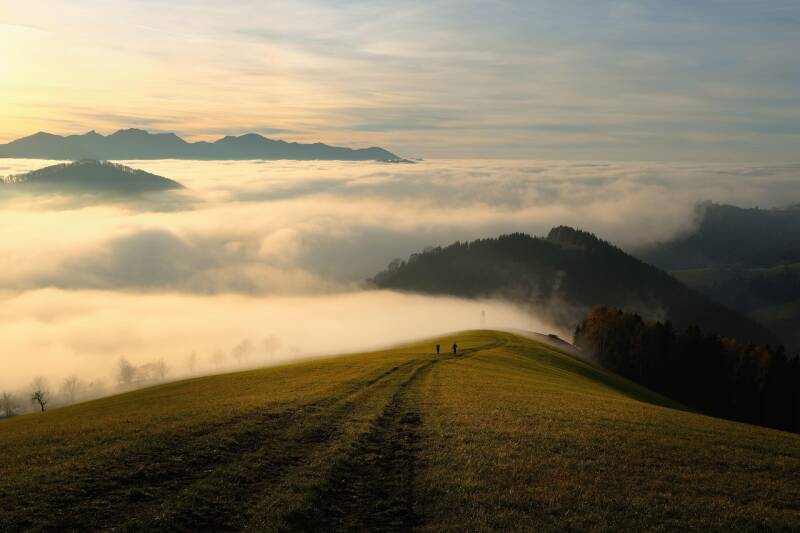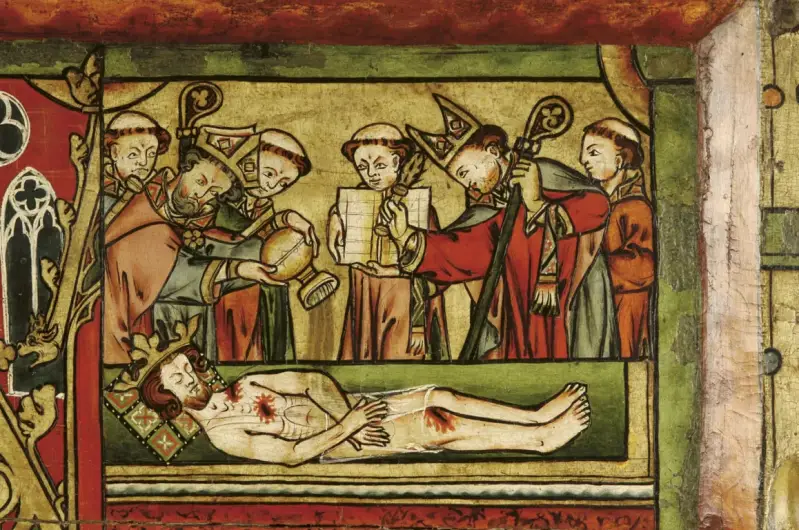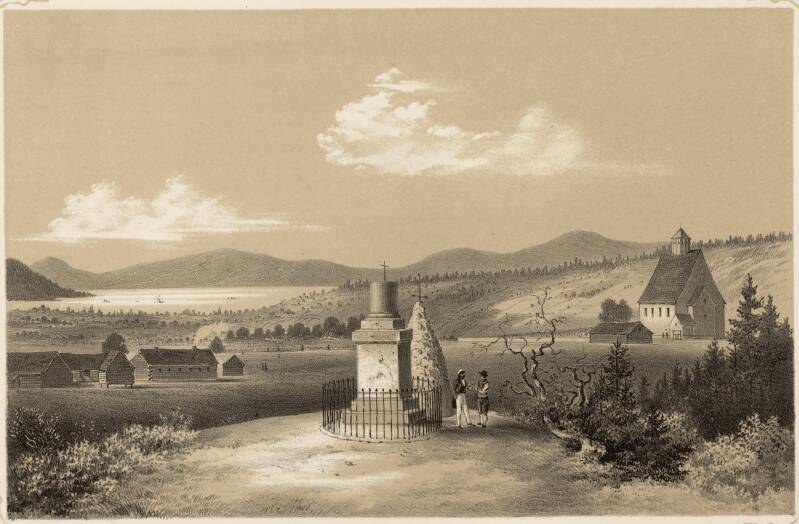There are roads we walk with our feet, and others we walk with our hearts. Some cut across ridgelines and fjords. Others across vineyards and medieval walls. But the most enduring paths are the ones that lead inward, toward the quiet truth that connects us all.
I grew up in the sun-drenched hills of Tuscany, where cypresses stand like sentinels along a road older than memory—the Via Francigena. This ancient pilgrim’s path, winding from Canterbury to Rome, passed not far from my childhood, stitching the landscape with silent footprints of seekers, travelers, and wanderers. I didn’t know it then, but the dust of those pilgrim feet was already stirring something in me.
The Via Francigena was the medieval superhighway of souls, carrying bishops, beggars, knights, and merchants toward the spiritual navel of Europe—Rome. After reaching Rome and St. Peter’s, the route continued southward through Italy, guiding pilgrims to the southern coastal ports from which they would set sail for the Holy Land.
As a child, I didn’t understand its depth. But I felt it. The road carried a weight, a whisper. A sense that walking wasn’t just about moving through space, but about being transformed by it.
Years later, far from the olive groves of my youth, I stood on another path—one colder, wilder, and wrapped in mist—the Saint Olav's Way. In Norway’s north, where the forests breathe ancient hymns and the fjords mirror the sky, I found another road carved by longing. It too led not only to a shrine, but to a self. And in that echo between two pilgrimages—Via Francigena and Saint Olav's Way—I discovered something more profound: a shared map of the soul, drawn in different lands, but always pointing in the same direction. Both roads were once acts of obedience to God. But to me, they are now acts of radical freedom. The freedom to pause. To choose solitude. To unlearn noise. To ask dangerous, necessary questions about life’s purpose and pain.
Saint Olav died on a battlefield, but became immortal in memory. His road is about transformation through sacrifice. The Via Francigena leads to Rome’s grandeur, but its magic lies in the humility of walking, of rediscovering the sacred in each sunrise, each stone chapel, each bowl of soup shared in silence. From Tuscany to Trondheim, these roads whisper the same truth. We are all pilgrims—not toward God or glory—but toward greater knowing, and deeper compassion.
Following the Footsteps of the Viking Saint: A Pilgrim’s Tale on Saint Olav's Way
The trail begins not just on a map, but in a story—a story carved into stone and legend, whispered across Nordic valleys and cathedral walls. It is the story of Olav Haraldsson, a Viking king who abandoned his sword for the cross, and whose death in 1030 would birth a legend that still walks the trails of Norway and Sweden nearly a thousand years later.
From Oslo to Trondheim, or as far back as Selånger in Sweden, thousands of pilgrims have walked these paths, chasing not miracles, but meaning.
Today, hikers carry trekking poles instead of rosaries, but the journey still transforms. One walks not just across land, but through memory—medieval farms, stave churches, and hills that hold the hush of centuries.
Saint Olav’s legend is no gentle tale. He was a warrior king, baptized far from home, and returned to reclaim his throne only to fall in the Battle of Stiklestad. But it was in death that his legacy grew. Miracles bloomed at his grave. Pilgrims came. And in time, the Nidaros Cathedral in Trondheim rose above his resting place—an Arctic Canterbury, glowing with Gothic spires and candlelight.
Saint Olav’s Way, often called “the Camino of the North,” is a pilgrimage unlike any other. Older, colder, and far quieter than its Spanish cousin, it invites walkers to slow down, reflect, and immerse themselves in a journey that is as much inward as it is northward.
Pilgrims set out with their Olav Passports, collecting stamps from remote churches and farms along the route. Each stamp is a small victory, a physical reminder of miles traveled and stories gathered. The trail leads through breathtaking landscapes, but the accommodations offer an equally authentic experience: medieval pilgrim hostels, humble rooms above barns, and quiet places where modern life feels worlds away. Crossing the Dovrefjell Mountains is one of the trail’s defining moments. The wild, wind-swept expanse was once thought to mark a spiritual boundary—a place where the earthly and divine meet. Today, it remains a test of endurance and a chance to feel connected to centuries of pilgrims who made the same journey.
At Stiklestad, history steps off the pages and into the present. Each midsummer, actors reenact the epic battle that transformed a king into a saint. It’s a moving reminder that this pilgrimage is not just a walk—it’s a living story carried forward through generations.
After days on the trail, pilgrims finally glimpse the spires of Nidaros Cathedral rising through the mist. The cathedral, green with copper and steeped in sacred history, is more than a destination—it’s a moment of quiet triumph.
Inside, some fall to their knees, overwhelmed. Others light candles for silent prayers carried over hundreds of miles. The bones of Saint Olav once rested here, and while the saint’s physical presence is gone, his spirit remains—a guardian of all who arrive.
Each pilgrim receives an Olavsbrev, a certificate marking their completion of the journey. But more than that, they take home a profound stillness, a realization that this pilgrimage was a journey inward as much as it was across Norway’s wild and beautiful north.
Nidaros Cathedral: Where Kings are Buried and Saints Rise
King Olav Haraldsson, exiled and dethroned, returned to Norway under the shadow of conflict. At Stiklestad, he met his end—not in triumph, but in martyrdom. His followers retrieved his body and buried him near the banks of the Nidelva in what was then Nidaros, present-day Trondheim.
The miracles began soon after. According to legend, his body remained incorrupt, and a healing spring emerged from his burial site. Within a year, Olav was declared a saint, canonized not by the Pope but by the people, and the cult of Olav grew faster than the Church could bless it. To honor his sanctity, a chapel was built.
Over centuries, this modest shrine evolved into a masterpiece, the Nidaros Cathedral, Scandinavia’s most sacred sanctuary.
Unlike the minimalist stave churches that dot Norway’s hills, Nidaros is a Gothic giant, hewn in stone and intricately adorned with saints, kings, gargoyles, and angels. Inspired by English and French cathedral styles, its western façade is a rich display of carved biblical drama and Norwegian legend.
Yet beneath the grandeur lies the grave of a single man: Saint Olav. His bones, once kept in a jewel-laden shrine, were moved and hidden during the Reformation. Their exact location remains a mystery, but the presence remains palpable. Pilgrims descend into the crypt to pay their respects, surrounded by the echo of centuries of prayer.
Nidaros is not just the endpoint of a journey—it is the symbolic heart of Norway. It served as the coronation church for Norwegian monarchs, and its altar became the site of national identity, combining statehood and sanctity.
Photo: www.pilegrimsleden.no
Stiklestad: Where a King Fell and a Saint Was Born
It was the summer of 1030. Norway was a young kingdom, restless and fragmented, a mosaic of warlords and ancient gods. Into this storm returned Olav Haraldsson, once king, now outlawed, seeking to reclaim his throne and spread the Christian faith across his homeland. But his return was met not with open arms, but with open swords.
At Stiklestad, a coalition of pagan chieftains, local rebels, and forces loyal to Cnut the Great stood against him. The king’s banner, golden and fierce, fluttered in the northern wind as blades rang and the ground shook. Amid cries and chaos, Olav fell, struck by multiple wounds, betrayed by his people.
The legend says that as Olav’s blood hit the earth, the land itself became hallowed. A blind man touched his lifeless hand—and saw. Springs flowed where his body lay. Within a year, he was no longer King Olav, but Saint Olav, canonized by his people as the eternal king of Norway.
It was one of the rare canonizations by popular acclaim, long before Rome gave its formal nod. The battle that was meant to end him became the spark of a spiritual revolution. Stiklestad had become not a battlefield, but a birthplace of a national faith.
A generation later, the memory of Stiklestad was etched into stone with the founding of Stiklestad Church, said to be built on the very spot where Olav died. Its altar stands, legend tells, upon the stone where he fell. Today, pilgrims still kneel there, whispering prayers into the silence of the nave.
The site became one of Norway’s earliest and holiest pilgrimage destinations, long before Nidaros Cathedral was finished. It was here that the idea of Christian Norway began to solidify—not by conversion, but by martyrdom.
Stiklestad in 1848, showing the St Olav memorial erected in 1807
Modern-day Stiklestad is a quiet village, steeped in memory and meaning. At its heart lies the Stiklestad National Cultural Centre, a place where Norway’s complex journey from paganism to Christianity comes vividly to life. Through immersive exhibitions at the Heritage Center, visitors explore the Viking Age and the birth of a Christian kingdom. A reconstructed medieval farm, complete with traditional crafts and costumed interpreters, offers a hands-on glimpse into daily life during Olav’s time. Guided walks lead visitors along the legendary final steps of the king, from the nearby river to the stone where he is said to have fallen. Yet Stiklestad is more than a historical site—it is a symbol of transformation. It marks the moment where Norway shifted from axe to altar, where battle gave way to belief. To walk its fields is to feel the weight of myth and memory pressing gently through the soil. Pilgrims still come, not for conquest, but for connection. For though King Olav met his end at Stiklestad, it is also where his legacy took root—no longer a ruler by sword, but a Saint in the hearts of a people.
Photo: Robert Eliassen / https://en.wikipedia.org/wiki/Stiklestad_Church#/media/File:Stiklestad_kirke.jpg








